
E-mail: font@focusonnature.com
Phone: Toll-free in USA 1-888-721-3555
or 302/529-1876
Website: www.focusonnature.com
 |
PO Box 9021,
Wilmington, DE 19809, USA E-mail: font@focusonnature.com Phone: Toll-free in USA 1-888-721-3555 or 302/529-1876 Website: www.focusonnature.com |
With
photos courtesy of tour participants and others.
Our
thanks to those who have contributed!
There
have been Focus On Nature Birding Tours in Chile,
with pelagic trips since 1990.
Links:
A
Summary of our Valparaiso Sea-Trip in November 2005
A list of seabirds during our CHILE tour in November 2003
our
chile sea-trips during the El Nino year of 1997
A LIST & PHOTO GALLERY OF CHILE BIRDS, in 2 Parts
UPCOMING
FONT BIRDING & NATURE TOURS IN CHILE
A
Listing
of Seabirds in Chilean waters
compiled by Armas Hill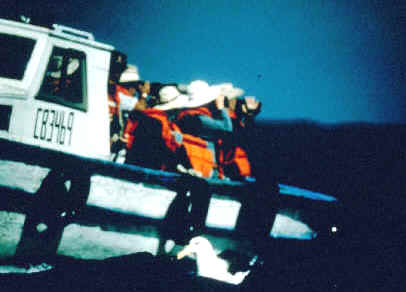
Codes:
In the Humboldt Current:
V: off Valparaiso, central Chile
A: off Arica, northern Chile
M: in Magellanic waters of
southern Chile (including
the Strait of Magellan)
(t): a globally threatened, or rare, species
as designated by Birdlife International
(t1): critical
(t2): endangered
(t3): vulnerable
(nt): a near-threatened species globally
(nt-dd): possibly a near-threatened species, but data deficient
CHr: rare in Chile
In the UPPER RIGHT PHOTO: Participants during a pelagic
trip out of Valparaiso, as part of a FONT Chile Tour, looking one way as a
Black-browed Albatross is on the water to their right.
2 boats were used during that trip. The photo was taken on the other
boat.
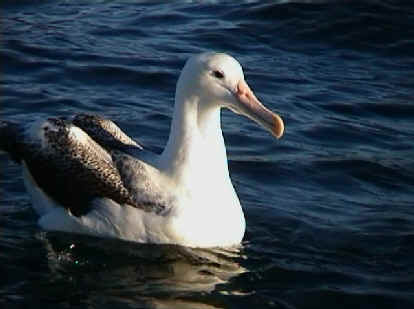
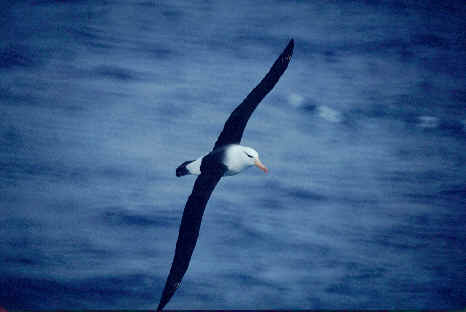
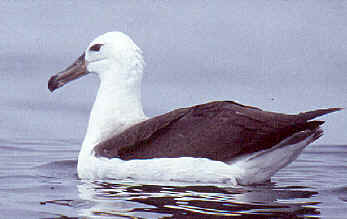
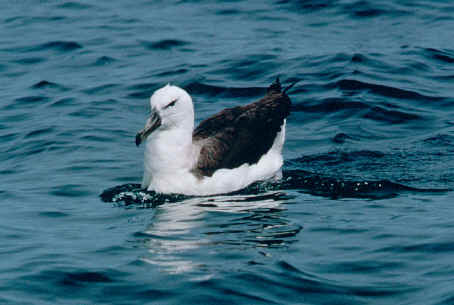
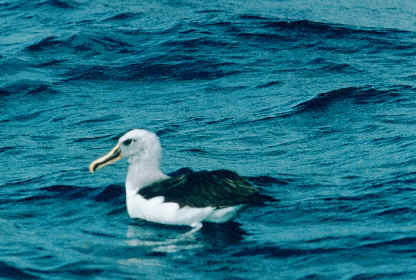
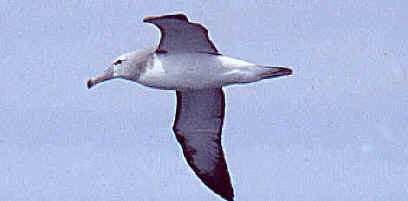

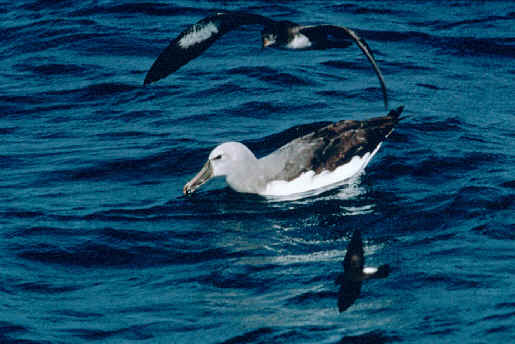
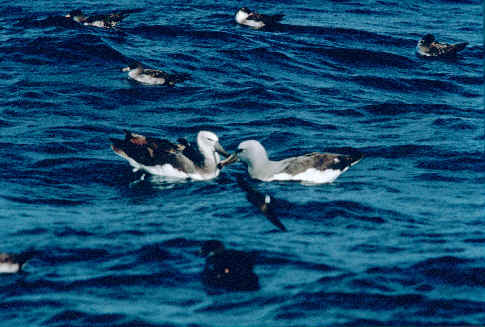
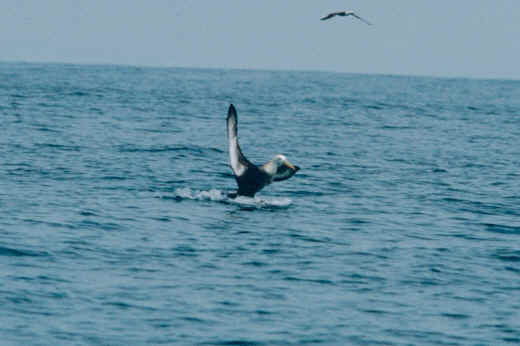
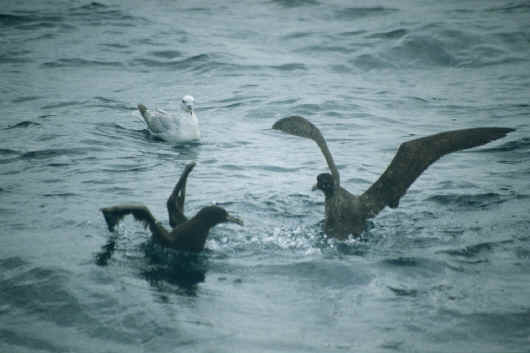
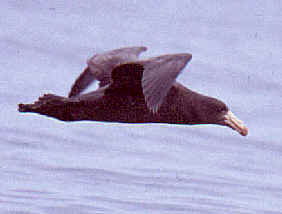
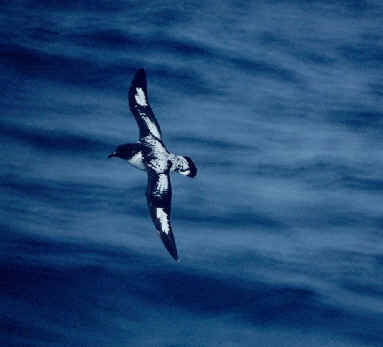
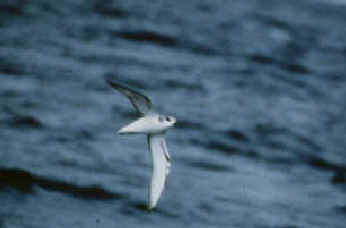
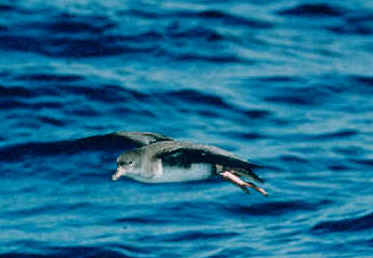
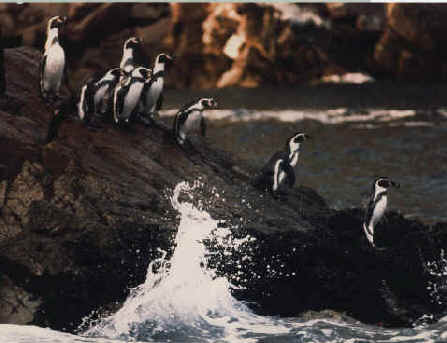
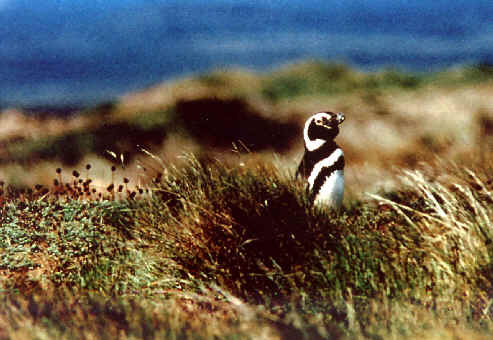
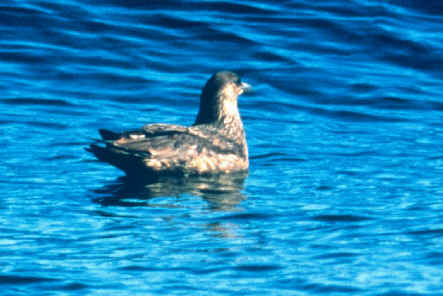
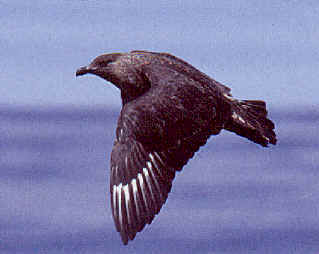
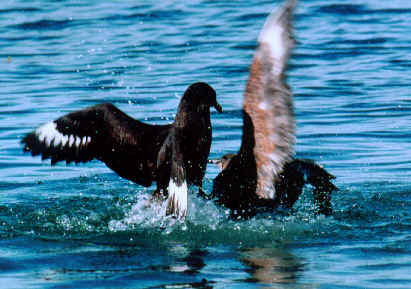
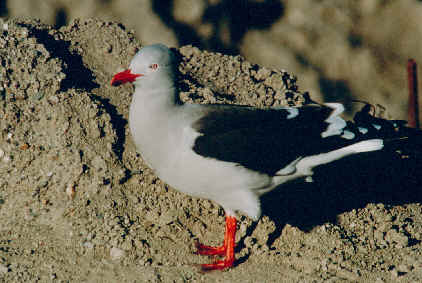
Kelp Gull
(called Dominican
Gull
in Australia,
New Zealand, & South Africa) ______ (V,A,M)
Larus dominicanus
A circumpolar resident on Antarctic and
sub-Antarctic islands in the southern Pacific, South Atlantic, and Indian
Oceans. Also along the coasts of South Africa, southern Australia, and New
Zealand. In South America, ranges along the Pacific as far north as
Ecuador, and along the Atlantic north to southern Brazil. On the Antarctic
Peninsula, ranges south to 68 degrees S.
Franklin's Gull ______
(V,A)
Larus pipixcan
During the northern summer, nests in North
America, in inland portions of the United States and southern Canada.
Outside its breeding season, a common to very common visitor to Chilean
offshore oceanic waters. Usually in flocks, it has been during FONT tours
off western South America in November, occurring with albatrosses and other
pelagic species of the Southern Hemisphere.

Franklin's Gull
(photo by Harold Lebo)
Laughing Gull ______
(A)
(1 in 1997, & 1 in
2003)
Larus atricilla
Only a very few occur as south as far-northern Chile.
Sabine's
Gull ______ (V,A)
Xema sabini
Breeds in the
Arctic. Occurs during the austral summer in Chilean offshore waters, as a
pelagic species.
Swallow-tailed
Gull ______ (A)
Creagrus furcatus
Occurs offshore
from northern Chile. Breeds in the Galapagos Islands.
Elegant
Tern ______ (V,A)
Sterna elegans
Breeds along the Pacific Coast of California
USA and Mexico. During the austral summer, occurs along the west coast of
South America. In Chile, as far south as Chiloe Island.
Sandwich
Tern ______ (A) (1 in 2003)
(rare in Chile)
Sterna sandvicensis acuflavidus
A very occasional
visitor along the Chilean Pacific Coast, with records as far south as
central Chile.
South
American Tern ______ (V,A)
Sterna hirundinacea
A common to very
common resident along the Chilean coast. The species ranges north along the
Pacific to Peru.
Common
Tern ______
(V,A)
Sterna hirundo hirundo
An uncommon
visitor from North America, during the austral summer, along the Pacific
coast and in offshore Chilean waters, occurring south to the Strait of
Magellan and Tierra del Fuego.)
Arctic
Tern ______ (V)
Sterna paradisea
An uncommon
visitor from the Northern Hemisphere, during the austral summer, south to
the southern tip of South America and beyond. In waters surrounding the
Antarctic Peninsula, it occurs as far south as 68 degrees S. Every year,
this species makes one of the most spectacular long-distance migrations of
any bird in the world.
Inca Tern
______ (V,A) (endemic to
the Humboldt Current)
Larosterna inca
Nests along the
desert coast of northern Chile and Peru. Ranges north to Ecuador. In Chile,
from Arica south to Corral (Los Lagos). Gregarious.
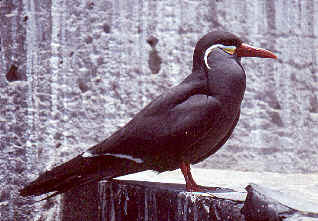
Inca Tern
Red (or Grey)
Phalarope ______ (V,A)
Phalaropus fulicaria
Breeds in the
Arctic. An offshore visitor, during the austral summer, commonly in Chilean
waters south to the latitude of Chiloe Island. Occasionally further south.
Outside its nesting season, a pelagic species.
Red-necked
Phalarope ______
(V,A)
Phalaropus lobatus
Breeds in the
Arctic. An offshore visitor from September to April, uncommonly in Chilean
waters south to the latitude of Los Lagos. Occasionally further south. Most
common off northern Chile. Outside its breeding season, essentially pelagic.
Other Maritime Species
along Chilean Coasts & Waterways
Neotropic
Cormorant
(has been called Olivaceous Cormorant) ______ (V,A)
Phalacrocorax brasilianus brasilianus
(in most of Chile)
Phalacrocorax brasilianus hornenis
(in far-southern Chile)
Occurs in a number of coastal and inland aquatic habitats.
Rock
Cormorant (or Rock Shag) (has
also been called Magellan Shag) ______
(M) (endemic to Patagonia)
Phalacrocorax magellanicus
Resident from
Corral (Los Lagos) south to the Diego Ramirez Islands. Most common in the
southern portion of its range. During the austral autumn, occasionally north
along the Pacific to Valparaiso.
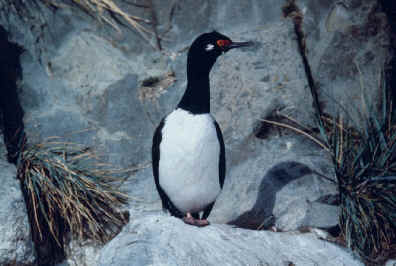
Rock Cormorant
Guanay
Cormorant (or Guanay Shag) ______
(or Guanay Shag) ______
(V,A)
Phalacrocorax bougainvillii
Along the Pacific Coast, common in northern
Chile and Peru. In Chile, occurs south to Mocha Island (Bio-Bio),
occasionally south to Corral (Los Lagos). Associates with other seabirds in
the presence of fish shoals in the Humboldt Current.
Imperial
Shag ______
(M) (endemic to Patagonia)
Phalacrocorax (atriceps) atriceps
(this and the
King Shag
(or
King Cormorant)
have been considered conspecific)
Resident in Chile from Santa
Maria Island (Bio-Bio) south to the Diego Ramirez Islands (Magallanes). More
common in the southern portion of its range. Mainly in waters influenced by
the Pacific Ocean, but some do occur in eastern Tierra del Fuego and by the
Atlantic.
King Shag
(or King Cormorant) ______ (M)
(endemic to Patagonia & the
Falklands/Malvinas)
Phalacrocorax (atriceps) albiventer
(this and the Imperial Shag have been considered conspecific)
Partly migratory resident from the Strait of
Magellan south to the Wollaston Archipelago (Cape Horn). Mainly in waters
influenced by the South Atlantic Ocean. During the austral winter, migrates
north along the Argentine coast.
Red-legged
Cormorant (or Red-legged Shag)
(nt) ______ (V,A)
Phalacrocorax gaimardi
A somewhat common
resident along the Pacific coast from Peru south in Chile to Corral (Los
Lagos). Scarce south of there. Classified as Near-threatened, with an
estimated population between 10,000 and 25,000 individuals.
Black-crowned
Night-Heron ______ (A,V,M)
Nycticorax nycticorax hoactli (at
Arica)
Nycticorax nycticorax obscurus (a darker form in areas of Valparaiso and the
Strait of Magellan)
Kelp Goose
______ (M)
(endemic to
Patagonia & the Falklands/Malvinas)
Choephaga hybrida hybrida
Along Chilean
coasts from Chiloe Island south to Tierra del Fuego, the Wollaston
Archipelago (Cape Horn) and the Diego Ramirez Islands. Generally in
territorial pairs in the summer, and in small loose flocks in the winter.
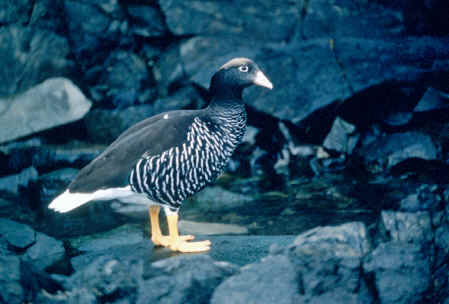
A
female Kelp Goose
Flightless
Steamer-Duck ______ (M)
(endemic to western Patagonian coasts and Tierra del
Fuego)
Tachyeres pteneres
Strictly coastal
species of the Pacific. Locally common resident from Corral (Los Lagos) and
Chiloe Island south to the southern Tierra del Fuego and the Wollaston
Archipelago (Cape Horn) More common in the southern portion of its range.
Generally in pairs or family groups during the breeding season. Occurs in
flocks of up to several hundred during the austral winter. Moves or
"steams" across the water surface by paddle-like wing-beats for
propulsion, supported also by its legs. The bird is unable to fly.
American
Oystercatcher ______ (V,A)
Haematopus palliatus pitanay
Locally common
summer resident along the Chilean coast south to Chiloe Island.
Haematopus palliatus durnfordi
Occurs along the South
Atlantic coast, but ranges, during the austral summer, into Chile in
Magallanes and along the coast of Tierra del Fuego.)
Blackish
Oystercatcher ______ (A)
Haematopus ater
Along Chilean
coasts from Peru south to Tierra del Fuego and the Wollaston Archipelago
(Cape Horn).
Magellanic
(or Fuegian) Oystercatcher ______
(M) (endemic to Patagonia)
Haematopus leucopodus
In Chile, south from
Chiloe Island to Tierra del Fuego and the Wollaston Archipelago (Cape Horn).
Occurs both coastally and in assorted inland habitats.
Snowy (or
American) Sheathbill ______
(M)
Chionis alba
Locally common resident, in the austral summer, on the Antarctic Peninsula,
on all the islands of the Scotia Arc, and on islands in the South Atlantic.
During the austral winter, migrates north in Chile along the coast to Los
Lagos. Some non-breeding adults remain throughout the year on eastern
Patagonian coasts, on Tierra del Fuego, and in the Diego Ramirez Islands.
Alone or in small loose flocks. A scavenger.
Chilean Seaside-Cinclodes ______
(V) (endemic to Chile)
Cinclodes nigrofumosus
From Arica south to Valdivia
along rocky marine coasts. Some other furnariids occur along fresh water.
Most live on land. This one by the sea.
![]()
A
Summary of the FONT Valparaiso Pelagic
Trip
in November 2005
An account written by tour leader,
Armas Hill
FONT conducted, on
November 14, 2005, its 16th Pelagic Trip from Valparaiso, in conjunction with its annual Chile Birding Tour. During most years, since 1991, this trip has been in November.Over the years, many seabirds have been seen during this
Valparaiso pelagic trip. Some years, the number of birds has been quite high, when there have been thousands of Sooty Shearwaters and thousands of phalaropes. This year, that was not the case, as the number of Sooty Shearwaters was small, and no phalaropes were seen. Some years, the waters of the Humboldt Current off Chile have been filled with seabirds that reside there exclusively. Species in that category include Guanay Cormorant and Peruvian Boobies. This year, numbers of both of those species seemed to be lower than usual.The ocean off the Chilean coast can have not just high numbers of birds, but also a good variety of species. During our trip in 2005, there was an excellent variety, even though, as noted, some of the numbers, that given day, were down.
Seabirds come to that area of the Pacific Ocean, off Chile, from various places far away. Some of the Albatrosses (including the Salvin's and the Buller's) come from New Zealand, on the opposite side of the Southern Pacific. Other birds also come from there, including the rare Westland Petrel.
During our tour this year, the bird that was the highlight of our Chile Valparaiso pelagic came from New Zealand, where the species breeds. It was the Northern Royal Albatross. We've previously seen the Southern Royal Albatross during our trips over the years (at least once, maybe twice), but this was the first time for the Northern. What an exciting bird our Northern Royal Albatross was to see. It's big, very big. Its wingspan is as much as 138 inches. That's 10-feet, 6-inches, meaning that each wing is as much as 5-feet, 3-inches, the height of many people.
We saw the Northern Royal Albatross well, with those long wings in flight, and also as it was resting near us on the water. When the bird would take off from the water to fly, each time we watched its feet patter along the surface for 2 or 3 seconds, before the bird would become airborne. Our Northern Royal Albatross on Nov. 14, '05 was an immature bird.
When it was resting on the water near us, next to the Salvin's Albatross, the Northern Royal dwarfed that species, which is no small bird itself. The wingspan of the Salvin's Albatross is as much as 98-inches, or about 8-feet, or 4-feet per wing. We saw a few Salvin's Albatrosses, during our trip. And, there was yet another Southern Albatross, the Black-Browed.
During our Chile Pelagic Trips, since
1990, we've seen 9 species of Albatrosses:
Northern Royal
Southern Royal
Black-browed
Salvin's
Shy (or White-capped)
Chatham
Buller's
Gray-headed,
and Waved.
Other seabirds during our Nov. 14, 2005
pelagic, from Valparaiso, Chile were:
the Westland Black Petrel (as noted, from New Zealand), the White-chinned,
and Cape Petrels (the latter known as the Pintado), the DeFilippi's
Petrel (a pterodroma very similar to the Cook's Petrel), the Southern
Giant-Petrel (one followed us nearly all the way back to shore), the Southern
Fulmar, the Pink-footed and Sooty Shearwaters, the Humboldt
Penguin, Peruvian Booby and Peruvian Pelican, Guanay and Red-legged
Cormorants.
Gulls
included the Kelp, and this year many Franklin's Gulls. It's
interesting how Franklin's Gulls can be on the ocean off the Chilean
coast, revising their life-style in the Southern Hemisphere. In the Northern
Hemisphere, of course, they breed far from the sea, in the interior of the
United States and Canada. A Sabine's Gull was also with the seabirds
around our boat off the Chilean coast, where we also saw an astonishing 6
species of Terns Common, Arctic, South American, Trudeau's, Elegant, and Inca.
It was a good day at sea.
![]()
Birds
during FONT Chilean pelagic trips
in November 2003
An account written by tour leader, Armas Hill
2003
was a good year for us pelagically off the coast of Chile. While for some
species numbers were not as high as they have been on occasion in the past,
virtually all of the good variety of species this year were seen well. Off
Valparaiso, out a little further and longer than other times, we enjoyed, with
the sun behind us, good looks at the oceanic birds, including the albatrosses,
close to the boat. The "chumming" brought the birds in. Some, such as
Pink-footed Shearwaters, could nearly be touched at the edge of the boat. The
oceanic waters off Arica were filled with fish (along with sea-lions and birds).
So the "chumming" there was rather ineffective. One of the highlights
of that trip was when a Peruvian Diving-Petrel, on the water by our boat,
moved in closer & closer as it seemed to be observing us!
In the following list of oceanic birds seen during our two pelagic trips, the red number relates to what was seen
off Valparaiso (v), the blue number off Arica (a).
Humboldt
Penguin v:8, a:6
Black-browed Albatross/Mollymawk v:15
Buller's Albatross/Mollymawk v:1 or 2
Salvin's Albatross/Mollymawk v:25,
a:1
Gray-headed Albatross/Mollymawk a: 1
Southern (or Antarctic) Giant-Petrel v:5
Southern (or Silver-grey) Fulmar v:1
Cape Petrel (or Pintado) v:8
Juan Fernandez Petrel v: 1 (possibly more)
DeFilippi's (or MasAtierra) Petrel v:10
Thin-/Slender-billed Prion v:3
White-chinned Petrel v:35, a:8
Westland (Black-) Petrel v:4
Pink-footed Shearwater v:30, a:4
Sooty Shearwaters v:200, a:30
Wilson's Storm-Petrel v:30, a:10
(possibly more)
Elliot's (or White-vented) Storm-Petrel a: 20-plus
Markham's Storm-Petrel a:2
Peruvian Diving-Petrel v:1,
a:10
Peruvian Pelican v:100, a:many
Peruvian Booby v:50, a:many
Blue-footed Booby a:1 (rare in Chile)
Brown Booby a:1 (rare in Chile)
Guanay Cormorant v:3,
a: a few
Red-legged Cormorant v:3
Red (or Grey) Phalarope v:25, a:1
Red-necked Phalarope a:25
Chilean Skua v:4
South Polar Skua a:1
Pomarine Jaeger a:1
Parasitic Jaeger a:30
Gray Gull a:many
Belcher's (formerly Band-tailed) Gull a:50
Kelp Gull v:dozens, a:1 or 2
Franklin's Gull v:100 a:200
Laughing Gull a:1
Sabine's Gull a:1
South Amercian Tern v:10 a:2
Common Tern v:1 (possibly more)
Arctic Tern v:5 (probably more)
Elegant Tern v:3, a:30
Sandwich Tern a:1 (rare in Chile)
Inca Tern v:20, a:100-plus
![]()
Birds
during FONT Chilean pelagic trips
in November 1997
An account written by tour leader,
Armas Hill
During
our more than a decade of pelagic trips off the Chilean coast, it was during
this year that the most birds were seen. That was due largely in part to the "El Nino phenomenon".
Another factor was our abundance of "chum". Anyway, our 2
pelagic birding trips off the coast of Chile in November '97 were among our
best ever!
There were always birds in large numbers around our boats. Nearly all of the
species were seen closely. Among them were 6 species of albatrosses!
One trip was on November 17, from Valparaiso, in central Chile. The other, on
November 27, was from Arica in northern Chile, just south of Peru.
Each trip lasted about 5 hours. Each went out about 15 miles offshore.
Regarding the "chum": During the Valparaiso trip, there were 11
buckets of it (fish parts). During the Arica trip, there were 6 buckets. A
second boat (from Arica) accompanied the boat with the birders. that second boat
was just to carry the chum. During both trips, the chumming was continuous.
In the following list of oceanic birds, the red number relates to what was seen
off Valparaiso (v), the blue number off Arica (a).
Humboldt
Penguin v:3 a:3
Black-browed Albatross (or Mollymawk) v:30 a:10
Buller's Albatross (or Mollymawk) v:5
Salvin's Albatross (or Mollymawk) v:50
a:3
Chatham (Island) Albatross (or Mollymawk) v:2 (or more)
Gray-headed Albatross (or Mollymawk) v:3
Waved (or Galapagos) Albatross a:15
Southern Giant-Petrel v:2
Southern (or Silver-grey) Fulmar v:4 a:2
Cape Petrel (or Pintado) v: 100 a:10
DeFilippi's (or MasAtierra) Petrel v:25
White-chinned Petrel v:15 a:8
Westland Petrel v:2
Pink-footed Shearwater v: a few thousand a:
10
Sooty Shearwaters v: thousands a:
800
a "Manx-type" shearwater (probably Townsend's) a:1
Wilson's Storm-Petrel v:1,000 a:100
White-vented (or Elliot's) Storm-Petrel a:50
Markham's Storm-Petrel a:1
Peruvian Diving-Petrel v:6
a:2
Peruvian Pelican v:1,000
a:
many,
many
Peruvian Booby v:200 a:5,000
(or more)
Guanay Cormorant v:10, a:3,000
Red-legged Cormorant v:6 a:3
(by the harbor)
Red (or Grey) Phalarope v:2 a:2
Chilean Skua v:6
South Polar Skua a:1
Pomarine Jaeger a:20
Long-tailed Jaeger a:1
Gray Gull v:10 a:1,000
Belcher's (formerly Band-tailed) Gull a:500
Kelp Gull v:hundreds a:100
Franklin's Gull v:many (mostly close to shore)
a:20,000
(10x that along the coast)
Laughing Gull a:1(an immature)
Sabine's Gull a:100 (50 in one flock)
South American Tern v:100 (other
terns possible)
Common Tern a:1
Elegant Tern v:3 a:30
Inca Tern v:1 a:100
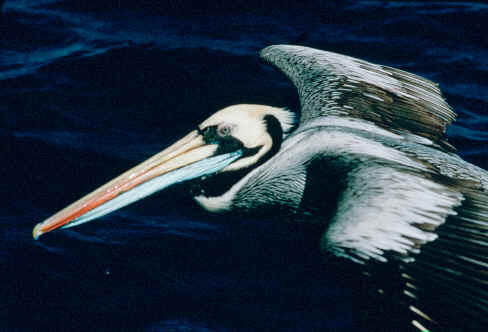
Peruvian
(or Chilean) Pelican,
photographed by Harold Lebo, off Valparaiso, Chile
The
Peruvian (or Chilean) Pelican is similar to, but larger than, its
northerly cousin, the Brown Pelican. Off Valparaiso, they accompanied the boat
well offshore, eating a hefty portion of the chum. Off Arica, they did not come
out as far at sea, but in Arica itself, particularly around the harbor, there
were thousands - walking tamely on the streets and docks, and en masse on roofs
of buildings and by boats where fishermen were preparing their catch. The
pelicans, along with numerous gulls, terns, and cormorants made quite a
spectacle at the fishing port of Arica. That city, as a matter of interest, is
surrounded by one of the driest deserts on earth, the Atacama, where one of the
Arican birds, the Gray Gull, breeds.
Off Valparaiso, particularly numerous were Sooty Shearwaters, in a
constant stream just offshore. That stream, of birds flying south, seemed to be
never-ending.
The apparent Townsend's Shearwater (noted in the list above), seen
off Arica, normally would occur further north over the Pacific, particularly off
Central America.
Prior to 1997, (as far as we know) there were no records of either the Chatham
Island Albatross or the Waved Albatross over Chilean waters. During
our '97 Arica pelagic trip, there were 15 Waved Albatrosses.
Some of our other albatrosses in '97, were, such as the Chatham Island Albatross, from
New Zealand and other islands in that area of the Pacific. Exceptions are the
Gray-headed Albatross (which breeds in far-southern Chile) and the Black-browed Albatross, which we also see during our
Chile tours much further to the south, often in large numbers, at the Strait of Magellan.
Highlights from previous
Chile tours
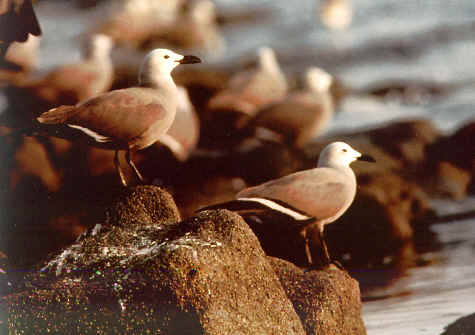
Gray
Gulls,
photographed by Harold Lebo, during a FONT tour in Arica, Chile.